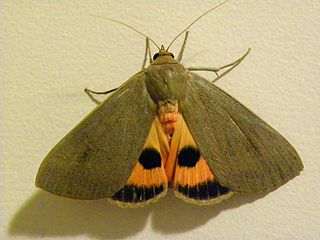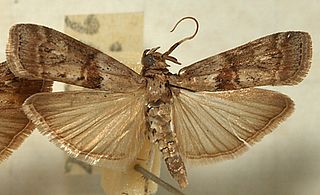
The Pyralidae, commonly called pyralid moths, snout moths or grass moths, are a family of Lepidoptera in the ditrysian superfamily Pyraloidea. In many classifications, the grass moths (Crambidae) are included in the Pyralidae as a subfamily, making the combined group one of the largest families in the Lepidoptera. The latest review by Eugene G. Munroe and Maria Alma Solis, in Kristensen (1999) retains the Crambidae as a full family of Pyraloidea.

The Pyralinae are the typical subfamily of snout moths and occur essentially worldwide, in some cases aided by involuntary introduction by humans. They are rather rare in the Americas however, and their diversity in the Australian region is also limited. Altogether, this subfamily includes about 900 described species, but new ones continue to be discovered. Like many of their relatives in the superfamily Pyraloidea, the caterpillar larvae of many Pyralinae – and in some cases even the adults – have evolved the ability to use unusual foods for nutrition; a few of these can become harmful to humans as pests of stored goods.

The Pyralini are a tribe of snout moths described by Pierre André Latreille in 1809. They belong to the subfamily Pyralinae, which contains the "typical" snout moths of the Old World and some other regions. The genus list presented here is provisional.

Microthyris is a genus of pyraloid moths, belonging to the subfamily Spilomelinae of the grass moth family (Crambidae). The genus was first described by Julius Lederer in 1863.
Ravanoa is a monotypic moth genus of the family Crambidae described by Frederic Moore in 1885. It contains only one species, Ravanoa xiphialis, described by Francis Walker in 1859, which is found in Sri Lanka, Myanmar and on Borneo.

The tortrix moth, genus Pammene, belongs to the tribe Grapholitini of the subfamily Olethreutinae.

Myelois is a genus of small moths belonging to the family Pyralidae. They are found in western Eurasia and adjacent regions such as the Maghreb.

Cadra is a genus of small moths belonging to the family Pyralidae. The genus Ephestia is closely related to Cadra and might be its senior synonym. Several of these moths are variously assigned to one or the other genus, in particular in non-entomological sources. Cadra and Ephestia belong to the huge snout moth subfamily Phycitinae, and therein to the tribe Phycitini.

Aglossa is a genus of small moths belonging to the family Pyralidae. It was described by Pierre André Latreille in 1796. They are found mainly in western Eurasia, though some species have been introduced elsewhere.

Scythris is a genus of gelechioid moths. It is the type genus of the flower moth family, which is sometimes included as a subfamily in the Xyloryctidae, or together with these merged into the Oecophoridae. The genus was erected by Jacob Hübner in 1825.

The Phycitinae are a subfamily of snout moths. Even though the Pyralidae subfamilies are all quite diverse, Phycitinae stand out even by standards of their family: with over 600 genera considered valid and more than 4000 species placed here at present, they unite up more than three-quarters of living snout moth diversity. Together with the closely related Epipaschiinae, they are apparently the most advanced lineage of snout moths.

Phycita is a genus of small moths belonging to the snout moth family (Pyralidae). They are the type genus of their tribe Phycitini and of the huge snout moth subfamily Phycitinae.

The Galleriinae are a subfamily of snout moths and occur essentially worldwide, in some cases aided by involuntary introduction by humans. This subfamily includes the wax moths, whose caterpillars (waxworms) are bred on a commercial scale as food for pets and as fishing bait; in the wild, these and other species of Galleriinae may also be harmful to humans as pests.

Apomyelois bistriatella is a species of snout moth in the genus Apomyelois. It was described by George Duryea Hulst in 1887. It is known from California, the eastern United States, northern Europe and Russia.
Apomyelois decolor, the Caribbean dried fruit moth, is a species of snout moth in the genus Apomyelois. It was described by Philipp Christoph Zeller in 1881. It is found in France, Florida, the Antilles, Central America and South America.
Chortonoeca is a monotypic snout moth genus in the family Pyralidae. Its single species, Chortonoeca leucocraspia, is known from Algeria. Both the genus and species were described by George Hampson in 1918.

Elegia is a genus of snout moths. It was described by Émile Louis Ragonot in 1887.
Ectomyelois is a genus of small moths belonging to the family Pyralidae.
Ectomyelois muriscis is a species of snout moth. It was described by Harrison Gray Dyar Jr. in 1914 and is widely distributed in Central America, northern South America, and the West Indian Archipelago.

Eurhodope cirrigerella is a species of snout moth in the genus Eurhodope. It was described by Johann Leopold Theodor Friedrich Zincken in 1818, and is known from most of Europe.














